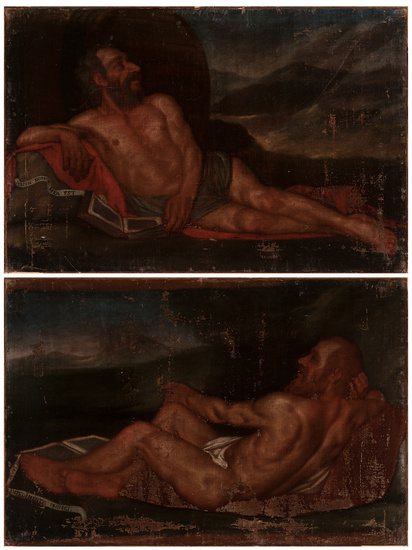“Diógenes y filósofo cínico” Escuela italiana; siglo XVII
Italian school; 17th century.
"Diogenes and Cynic Philosopher".
Pair of oils on canvas. Re-coloured.
They show damages.
Measurements: 72 x 110 cm (x2).
The Greek Diogenes of Sinope (404-323 B.C.) was a cynical philosopher, a wise man who lived as a vagabond in the streets of Athens, sleeping in a barrel. His only possessions were a house in the shape of a jar, a blanket, a bag, a staff and a bowl (and this he gave to a child who drank with his hands). Diogenes turned all this poverty into virtue. It is said that the philosopher went about the streets in broad daylight carrying the lamp, with which he "looked for honest men". Of course, not even the first one turned up. Diogenes was always surrounded by dogs, symbols of cynical philosophy ("kynikos": similar to a dog), because of his radical idea of freedom, his shamelessness and his continuous attacks on traditions and social ways of life. In this particular case, the iconographic elements that define Diogenes, such as the lantern and the dogs, are not visible, but in both paintings there is an inscription "Dolim domus mea est", the barrel is my casam, alluding to one of his few possessions. The other inscription reads "in mare impedimenta protecci", I protect myself from the dangers of the sea, which may be an allusion to his capture and subsequent sale as a slave by pirates.
In each of the works the author presents different philosophers as the protagonists of each of the scenes. To portray these characters, the artist has opted for similar compositions, in which he has the main character lying down, although in both compositions the postures adopted by the bodies are different, as one is facing frontally, with his face turned, while the other character is in profile. The two figures are set in a landscape. In addition, each philosopher has a book, which is shown open to the viewer, and a band on which the aforementioned inscriptions can be seen. Despite these similarities, each scene is different, both in the environment in which each character is set and in the personal traits of the characters.
Presentan desperfectos.
View it on
Estimate
Time, Location
Auction House
Italian school; 17th century.
"Diogenes and Cynic Philosopher".
Pair of oils on canvas. Re-coloured.
They show damages.
Measurements: 72 x 110 cm (x2).
The Greek Diogenes of Sinope (404-323 B.C.) was a cynical philosopher, a wise man who lived as a vagabond in the streets of Athens, sleeping in a barrel. His only possessions were a house in the shape of a jar, a blanket, a bag, a staff and a bowl (and this he gave to a child who drank with his hands). Diogenes turned all this poverty into virtue. It is said that the philosopher went about the streets in broad daylight carrying the lamp, with which he "looked for honest men". Of course, not even the first one turned up. Diogenes was always surrounded by dogs, symbols of cynical philosophy ("kynikos": similar to a dog), because of his radical idea of freedom, his shamelessness and his continuous attacks on traditions and social ways of life. In this particular case, the iconographic elements that define Diogenes, such as the lantern and the dogs, are not visible, but in both paintings there is an inscription "Dolim domus mea est", the barrel is my casam, alluding to one of his few possessions. The other inscription reads "in mare impedimenta protecci", I protect myself from the dangers of the sea, which may be an allusion to his capture and subsequent sale as a slave by pirates.
In each of the works the author presents different philosophers as the protagonists of each of the scenes. To portray these characters, the artist has opted for similar compositions, in which he has the main character lying down, although in both compositions the postures adopted by the bodies are different, as one is facing frontally, with his face turned, while the other character is in profile. The two figures are set in a landscape. In addition, each philosopher has a book, which is shown open to the viewer, and a band on which the aforementioned inscriptions can be seen. Despite these similarities, each scene is different, both in the environment in which each character is set and in the personal traits of the characters.
Presentan desperfectos.



